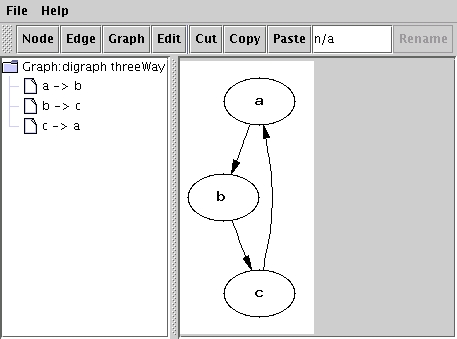
TINTFU can parse DOT files and render a preview of them in a side pane, while allowing each and every attribute of Graphs, SubGraphs and Nodes to be edited. The results of such changes are immediately updated in the preview pane.
|
Please welcome a new developer to this project: Matt Payne. You will find his version, also the latest version of TINTFU, at the bottom of this page.
|
|
Also parked here is a spin-off of finding out how WebStart(tm) and Applets
can be deployed. The same game (an AI version of a certain well-known
mine seeking game) can be run both as an
Applet and through WebStart. If I use Mozilla for the Applet version it almost always dies. But it does that on anything Java nowdays :( Other browsers work fine. The source of the game is here. |
The current BETA version can be started with:
java -jar tintfu_x_y_z.jaror
java -cp tintfu_x_y_z.jar net.sourceforge.tintfu.DotEditorwhere _x_y_z is the version, eg. java -jar tintfu_0_0_3.jar.
Alternatively, if you have webstart, you may click this link to download and start the latest version. Please ignore the security warning, the application must be able to read and write files.
digraph threeWay { a -> b ; b -> c ; c -> a }
If rendered using "dot -Tpng 3.dot >3.png" it yields the following graph:

And this is a screenshot of TINTFU working on this file:

This is a slightly more complex example:
digraph "DotFileParser" {
size="12.8,10.24";
"node0" [ label="BOF" shape=ellipse ];
"node1" [ label="EOF" shape=ellipse ];
"node2" [ label="graphName" shape=ellipse ];
"node3" [ label="{" shape=ellipse ];
"node4" [ label="stmtList" shape=ellipse ];
"node5" [ label="graphAttrib" shape=ellipse ];
"node6" [ label="node" shape=ellipse ];
"node7" [ label="edge" shape=ellipse ];
"node8" [ label="}" shape=ellipse ];
"node9" [ label="nodeName" shape=ellipse ];
"node10" [ label="edgePair" shape=ellipse ];
"node11" [ label="nodeList" shape=ellipse ];
"node12" [ label="edgeList" shape=ellipse ];
"node13" [ label="nodeAttrib" shape=ellipse ];
"node14" [ label="edgeAttrib" shape=ellipse ];
"node0" -> "node1" [ color=black fontcolor=black label="Empty file" ];
"node0" -> "node2" [ color=black ];
"node2" -> "node3" [ color=black ];
"node3" -> "node4" [ color=black ];
"node4" -> "node5" [ color=black ];
"node5" -> "node4" [ color=black ];
"node4" -> "node6" [ color=black ];
"node4" -> "node7" [ color=black ];
"node4" -> "node3" [ color=black fontcolor=black label="subGraph" ];
"node4" -> "node8" [ color=black ];
"node8" -> "node4" [ color=black ];
"node8" -> "node1" [ color=black ];
"node6" -> "node9" [ color=black ];
"node7" -> "node10" [ color=black ];
"node9" -> "node11" [ color=black fontcolor=black label="[" ];
"node9" -> "node4" [ color=black ];
"node10" -> "node12" [ color=black fontcolor=black label="[" ];
"node10" -> "node4" [ color=black ];
"node11" -> "node4" [ color=black fontcolor=black label="]" ];
"node12" -> "node4" [ color=black fontcolor=black label="]" ];
"node11" -> "node13" [ color=black ];
"node13" -> "node11" [ color=black ];
"node12" -> "node14" [ color=black ];
"node14" -> "node12" [ color=black ];
}
This actually is the state machine used by the DOT file parser in version 0.0.1
of this program. It yields this graph:

Mon Jul 28 2003 - Payne@MattPayne.org changed three source files to:
Just pick the choice under the file menu and click OK to use the server that's already out there. Or enter the URL of your own. The server (dot.php) is in CVS next to the Java source files.
Also see my company website, in Dutch only (for now).